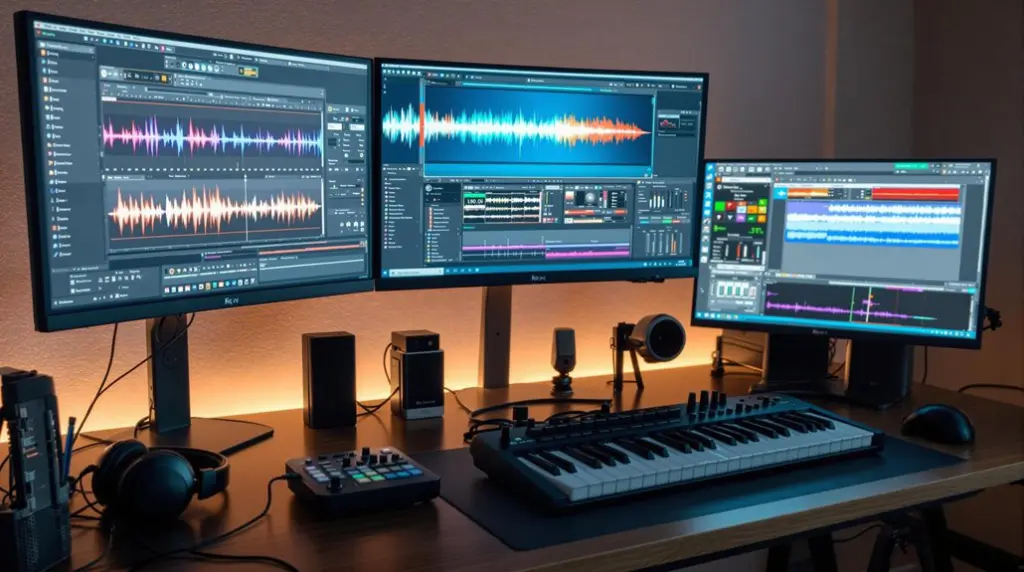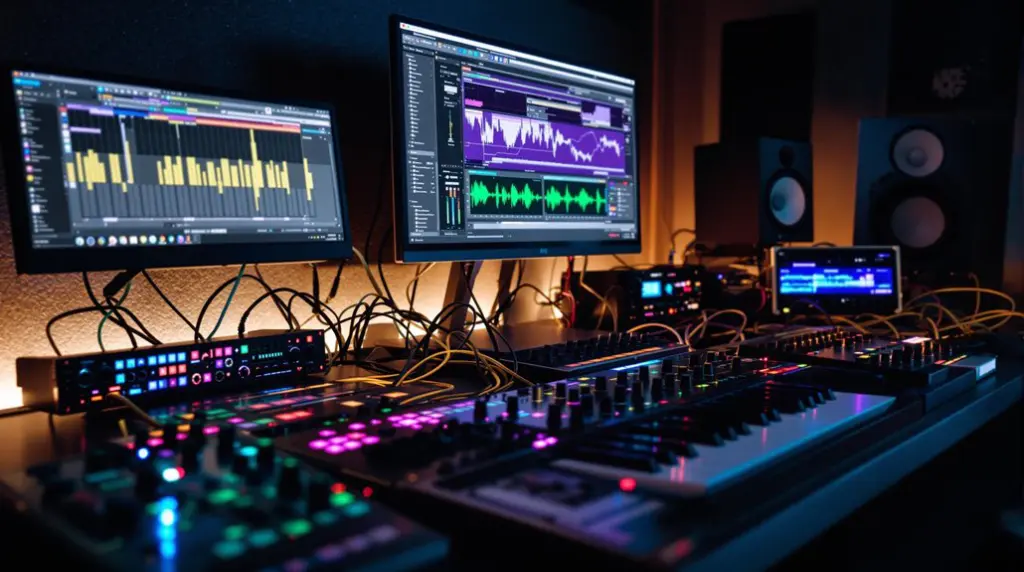Yes, you’ll need an audio interface for best performance with studio monitors. An audio interface converts analog audio signals to digital and vice versa, ensuring high-fidelity sound. It offers USB, Thunderbolt, and PCIe connectivity and provides clean, isolated power to minimize interference. Without an interface, you might connect directly through your computer’s headphone jack, but that’s not professional-grade. An interface allows precise control over volume and signal flow, enhancing audio quality greatly. To explore the benefits and find the right model for your needs, it’s worth learning more about interfaces and their features.
Key Takeaways
- An audio interface enhances audio quality with better resolution and higher rates.
- It reduces hardware noise floor for a cleaner audio output.
- An interface provides precise control over volume levels and signal flow.
- It ensures compatibility and connectivity between studio monitors and your computer.
- While temporary setups can use direct connections, an interface is recommended for professional use.
What Is an Audio Interface?
An audio interface is the vital device that converts analog audio signals to digital and vice versa, enabling seamless connectivity between your studio monitors and computer. It performs essential functions like analog-to-digital (A/D) conversion and digital-to-analog (D/A) conversion, guaranteeing that the sound you capture and playback maintains high fidelity. Without these conversions, your computer wouldn’t be able to process the audio signals from your microphones or play back high-quality sound through your studio monitors.
When selecting an audio interface, you’ll encounter various interface connectivity options. USB, Thunderbolt, and PCIe are common types, each offering different levels of speed and performance. USB interfaces are widely used due to their balance of affordability and decent latency. Thunderbolt interfaces, though pricier, provide lower latency and higher bandwidth, making them suitable for professional environments. PCIe options are typically reserved for high-end setups requiring ultra-low latency and maximum throughput.
Understanding the difference between analog and digital conversion is essential. Analog signals are continuous waveforms, while digital signals are discrete data points. An audio interface’s job is to accurately convert these signals, minimizing latency and preserving sound quality. This ensures your studio monitors reproduce sound precisely, enhancing your overall audio experience.
Benefits of Using an Audio Interface
Selecting the right audio interface not only bridges the gap between analog and digital worlds but also greatly enhances your studio monitors’ performance. By investing in an audio interface, you notably improve the audio quality through better resolution and higher audio rates. The improved DAC (Digital-to-Analog Converter) quality guarantees that your listening experience is crisp and detailed, allowing you to discern subtle nuances in your audio tracks.
An audio interface also reduces the hardware noise floor, providing cleaner audio output. Enhanced power isolation further minimizes interference, ensuring that your studio monitors deliver impeccable sound. This setup allows smoother signal flow and greater control over volume levels, giving you precise command over your audio environment.
Moreover, an audio interface future-proofs your setup, offering compatibility with various input/output formats for top-notch performance. This ensures that your studio can adapt to evolving technology standards, maintaining top performance levels.
Here’s a quick comparison to help you understand the benefits:
| Feature | Without Interface | With Interface |
|---|---|---|
| Audio Quality | Lower resolution, noisy | High resolution, clean |
| Signal Flow | Basic, limited control | Smooth, precise control |
| Future Compatibility | Limited, rigid | Flexible, future-proof |
Connecting Studio Monitors Without an Interface
To connect studio monitors without an audio interface, you’ll typically use a cable with quarter-inch jacks to link the monitors directly to your computer’s headphone jack. Before making any connections, make sure the monitors are turned off and the volume is set to a minimum to avoid sudden loud sounds. This DIY solution is effective for temporary setups, such as playing music from YouTube or iTunes, but it’s not recommended for professional music production.
When implementing this method, follow the correct sequence to prevent popping sounds: plug in the cables first, then turn on the monitors, and finally adjust the volume to monitor sound levels. If you encounter issues, troubleshoot by checking for loose connections, verifying your computer’s audio settings, and ensuring the monitors have a stable power source.
Alternative methods include using a 3.5mm to dual quarter-inch cable, which can streamline the connection process. However, be aware that this approach may not deliver the same audio quality as a dedicated audio interface. Therefore, while these methods can serve in a pinch, they mightn’t meet the high standards required for professional audio work.
Choosing the Right Audio Interface
For a professional setup, choosing the right audio interface for your studio monitors becomes essential after understanding the limitations of direct connections. You need to take into account several critical factors to guarantee peak performance.
First, evaluate the number of physical inputs and outputs you’ll need. This includes balanced outputs for your monitors and any additional gear you plan to use. Quality converters are key for accurate sound reproduction, so prioritize interfaces with high-fidelity digital-to-analog converters.
Next, assess interface compatibility with your studio monitors. Not all interfaces will work seamlessly with all monitor types, so make sure that the specifications align.
Interface connectivity is another important consideration. Choose between USB, Thunderbolt, or Ethernet based on your computer and existing equipment. USB interfaces are widely compatible, whereas Thunderbolt offers faster data transfer rates, beneficial for larger projects.
Don’t overlook practical features like headphone outputs and volume controls, which facilitate precise monitoring. Also, think about future expansion. You might need additional inputs or advanced features down the line, so selecting an interface with some room for growth can be a wise investment.
Recommended Audio Interfaces for Beginners
Often, beginners will find that entry-level audio interfaces like the Behringer U-Phoria UM2, Focusrite Scarlett 2i2, and PreSonus AudioBox USB96 offer the essential features needed to start recording with studio monitors. These budget-friendly options are ideal for novice users, providing 1-2 inputs, headphone outputs, and speaker controls to cater to basic recording needs.
When selecting an audio interface, there are several features to take into account. Firstly, make sure the model includes mic and instrument inputs, which are vital for capturing various audio sources. Headphone outputs are necessary for monitoring your recordings in real-time, while speaker controls allow you to manage your studio monitors effectively.
Brands like SSL, Audient, and Behringer offer affordable options without compromising on sonic quality, making them excellent choices for beginners.
Starting with a basic interface enables you to focus on developing your recording skills without being overwhelmed by advanced features. As your proficiency and budget grow, you can consider upgrading to more complex models. By prioritizing these core functionalities, you’ll establish a solid foundation for your recording setup, ensuring a smooth and productive learning experience.
Frequently Asked Questions
Do Studio Monitors Need an Interface?
You don’t need an interface for studio monitors, but it’s essential for ideal speaker placement and room acoustics. The interface guarantees proper signal conversion, enhancing audio quality and providing necessary connections for better control over your sound environment.
Do You Really Need an Audio Interface?
You really need an audio interface for the best sound quality and professional setups. It guarantees accurate audio playback, improved volume control, and reliable signal routing, making it essential for connecting studio monitors to your computer effectively.
What Do You Need to Use Studio Monitors?
To use studio monitors, make sure proper cabling requirements with XLR or TRS cables, consider room acoustics for ideal placement, and use an audio interface or mixer for sound output. Stable power and appropriate volume levels are also essential.
Can You Use an Audio Interface Without Studio Monitors?
Yes, you can use an audio interface without studio monitors. Headphones compatibility guarantees recording convenience, allowing you to monitor audio directly. This setup is ideal for mobile recording, providing precise monitoring without needing bulky equipment.
Conclusion
Ultimately, using an audio interface with your studio monitors greatly enhances sound quality and provides greater control over your audio setup.
While you can connect monitors directly to your computer, an interface offers superior audio fidelity, lower latency, and expanded connectivity options.
Evaluate your needs and budget when choosing the right interface. For beginners, starting with a recommended model guarantees you’ll achieve professional results without unnecessary complexity.
Investing in an audio interface is a wise decision for any serious audio enthusiast.




